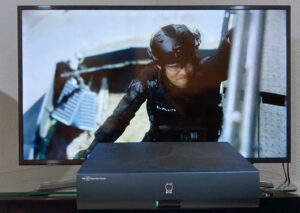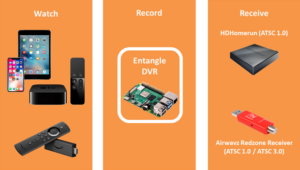September 11, 2002 holds a special meaning for a handful of (now ex-) TiVoites: the first showing of a HD standalone prototype, which had been under development in stealth mode for the better part of a year.
The Defiant was skunk-worked by two former engineers (one of them yours truly) who had been demoted into management. We couldn’t have done it without the TiVo team at Broadcom, whose passion for all things TiVo led them to work with us to unlock the BCM7020’s full potential long before there was a glimmer of a commercial project.

The Defiant was a derivative of the the highly versatile “3-chip” architecture that underlay many of the Series 2 TiVo Standalone, DVD, and DIRECTV platforms. (The three chips being the BCM7020, the NEC VR5432 MIPS CPU, and the TiVo ASIC. As TiVo’s CTO mentioned while holding up a prototype board at a company all-hands, the board seemed to have a lot more than three chips…) At the heart of the architecture is the Broadcom BCM7020 High Definition UMA Subsystem with 2D Graphics.
The Defiant set the stage for a number of future HD-capable TiVo platforms. Shortly after the September 11 showing there was a meeting at DIRECTV where they indicated their desire for a future HD platform. And what a shame it was that TiVo didn’t have one. A TiVo executive at the meeting, who was at the 9/11 unveiling, quickly corrected that misconception. And so began the Phoenix (aka DIRECTV HR10-250) project. Variations on the Defiant prototype also served to explore digital cable, which led to the “Armstrong” and eventually the”Eiger” (i.e. TiVo Series 3) projects.
There was a lot more to HD than just attaching an ATSC tuner to the board, and while we were certain the initial user base would be early adopter techies, we wanted the HD TiVos to proudly carry the torch of devices “grandma could use.” The Defiant explored the nuances of HD and the best way to make them available to consumers. There were multiple resolutions – 480i, 720p, and 1080i. Two display aspect ratios – 4:3 and 16:9 (with many stations getting them wrong in those days, so manual aspect ratio correction, or zoom modes, were a must!). And back then a lot of TVs were still 4:3, with widescreen 16:9 being the odd new kid on the block. A lot of experimentation went into the best way to make video presentation and the UI work on the various combinations of TVs and video resolutions. The 19.4 Mbit/s ATSC bitrate was also quite a bit higher than the 6 Mbit/s of TiVo Best Quality (and back then there are quite a few ATSC emissions carrying just one HD channel and maybe one or two SD subchannels, so bit rates between 15 and 19 Mbit/s weren’t uncommon.) TiVo was known for its ease of use, and we wanted HD TiVos to be as intuitive as their SD counterparts.
Some fun facts…
- The Defiant was named after the Star Trek Deep Space 9 starship Defiant. TiVo platforms have naming schemes (3-chip standalones were named after rivers), and the Defiant was the first in a line of Series2 HD platforms christened after Star Trek starship classes.
- Much like its namesake, the Defiant was “over-gunned and overpowered for a ship its size…it nearly tore itself apart when the engine were tested at full capacity.” While the 3-chip architecture provided a solid foundation for Series2 standalones, the early Defiant prototypes had a tendency to crash fast and hard when pushed to its full capability (er, recording and playing high-bitrate HD). Many hours were spent stabilizing and performance-enhancing the platform before its unveiling.
- The “Defiant PX-1 blue-wire prototype” was a TiVo Series 2 “240” system board, a NextWave NX2002 ATSC tuner, and a lot of wire. The wire was probably blue. Over the next year stuff option support for the tuner and things like HD component video output somehow made their way to the early PCBs for the next TiVo standalone models .
- The first successful operation of the HD record and playback path resulted in the display of a spiral ham commercial from a live ATSC broadcast out of the composite video port. This was most likely around Easter 2002. We got a few seconds of playback before the system crashed, but we left the lab overjoyed that night. And with a craving for ham.
- The Defiant’s cloaking device worked admirably. Despite being under “active” development for nearly a year prior to its September 2002 unveiling, the number of people who knew of its existence could be counted on one hand.
- The first public showcasing of the Defiant was in the TiVo booth at CES in January 2003. A prototype of the Phoenix, its DIRECTV counterpart, also made its debut at the show in the TiVo and DIRECTV booths.
- While TiVo had an internal RF cable plant (the “TiVo headend”), it didn’t include ATSC channels when Defiant was being skunk-worked. For its unveiling (during a meeting with a certain largish CE), the team walked into the meeting room with the Defiant prototype. And a large bar antenna. It took a bit of gymnastics but the team was able to demo reception and trick play of live ATSC broadcasts.

 Three exciting events have recently occurred in the normally sleepy region of Fresno, California. First, Cocola Broadcasting brought an RF 6 ATSC 3.0 “Frankenstation” on line. With UHD content! Second Sinclair launched its emission. Third, the temperature in mid-June was unseasonably cool for a couple days (highs in 70s). With that confluence of events we just had to trek out and see what NextGen Fresno had to offer!
Three exciting events have recently occurred in the normally sleepy region of Fresno, California. First, Cocola Broadcasting brought an RF 6 ATSC 3.0 “Frankenstation” on line. With UHD content! Second Sinclair launched its emission. Third, the temperature in mid-June was unseasonably cool for a couple days (highs in 70s). With that confluence of events we just had to trek out and see what NextGen Fresno had to offer!